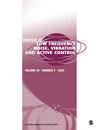Acoustic impedance extraction method and acoustic characteristics analysis of perforated plates under grazing flow
IF 2.4
4区 工程技术
Q1 ACOUSTICS
Journal of Low Frequency Noise Vibration and Active Control
Pub Date : 2023-08-06
DOI:10.1177/14613484231186694
引用次数: 0
Abstract
As an important component of inlet and exhaust mufflers, the acoustic characteristics of perforated components are inevitably affected by the flow of air. Therefore, obtaining the acoustic impedance of the perforated element under airflow conditions is a prerequisite for accurate calculation of the muffler’s muffling performance. In this work, the frequency domain linear Navier–Stokes (L-NS) method is used to extract the acoustic impedance of perforated plates under grazing flow. The predicted perforated acoustic impedance is consistent with the calculation results of published acoustic impedance expression, and the impedance boundary condition is defined to calculate the transmission loss (TL) of the perforated muffler, which agrees well with the experimental results and verifies the accuracy of the method. The effect of perforation angles on the transmission loss of mufflers in different Mach numbers ( Ma) and aperture plate thickness ratio ( dh/ tp) is analyzed by the frequency domain L-NS method. The results show that when 1≤ dh/ tp<2 and Ma≤2, the effect of perforation angles on the muffler performance is obvious, and the angle tilted upstream shifts the resonant frequency to a lower frequency while its corresponding peak value is also increased. As an engineering application, it has certain significance for the prediction of muffler muffling performance and the regulation of the muffling frequency band.掠流作用下穿孔板声阻抗提取方法及声特性分析
穿孔构件作为进排气消声器的重要组成部分,其声学特性不可避免地会受到气流的影响。因此,获得气流条件下穿孔元件的声阻抗是准确计算消声器消声性能的前提。本文采用频域线性Navier-Stokes (L-NS)方法提取了在掠流作用下穿孔板的声阻抗。预测的穿孔声阻抗与已发表的声阻抗表达式的计算结果一致,并定义了阻抗边界条件来计算穿孔消声器的传输损耗,与实验结果吻合较好,验证了该方法的准确性。采用频域L-NS方法分析了不同马赫数(Ma)和不同孔径板厚度比(dh/ tp)下,穿孔角对消声器传输损失的影响。结果表明:当1≤dh/ tp<2, Ma≤2时,穿孔角对消声器性能的影响较为明显,向上倾斜的穿孔角使消声器的谐振频率向较低的频率偏移,其峰值增大;作为工程应用,对消声器消声性能的预测和消声频带的调节具有一定的意义。
本文章由计算机程序翻译,如有差异,请以英文原文为准。
求助全文
约1分钟内获得全文
求助全文
来源期刊

Journal of Low Frequency Noise Vibration and Active Control
Engineering-Mechanical Engineering
CiteScore
4.90
自引率
4.30%
发文量
98
审稿时长
15 weeks
期刊介绍:
Journal of Low Frequency Noise, Vibration & Active Control is a peer-reviewed, open access journal, bringing together material which otherwise would be scattered. The journal is the cornerstone of the creation of a unified corpus of knowledge on the subject.
 求助内容:
求助内容: 应助结果提醒方式:
应助结果提醒方式:


